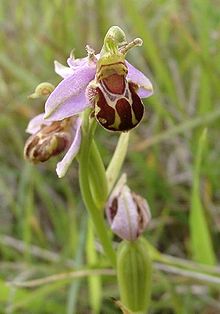| Ophrys | |
|---|---|

| |
| Bee orchid (Ophrys apifera var. aurita) | |
| Scientific classification | |
| Kingdom: | Plantae |
| Clade: | Tracheophytes |
| Clade: | Angiosperms |
| Clade: | Monocots |
| Order: | Asparagales |
| Family: | Orchidaceae |
| Subfamily: | Orchidoideae |
| Tribe: | Orchideae |
| Subtribe: | Orchidinae |
| Genus: | Ophrys L., 1753 |
| Type species | |
| Ophrys insectifera[1] L., 1753
| |
| Synonyms[2] | |
| |
The genus Ophrys is a large group of orchids from the alliance Orchis in the subtribe Orchidinae. They are widespread across much of Europe, North Africa, Caucasus, the Canary Islands, and the Middle East as far east as Turkmenistan.[2][3]
These plants are remarkable in that they successfully reproduce through pseudocopulation, that is, their flowers mimic female insects to such a degree that amorous males are fooled into mating with the flowers, thereby pollinating them. There are many natural hybrids.
They are referred to as the "bee orchids" due to the flowers of some species resemblance to the furry bodies of bees and other insects. Their scientific name Ophrys is the Greek word for "eyebrow", referring to the furry edges of the lips of several species.[4]
Ophrys was first mentioned in the book "Natural History" by Pliny the Elder (23-79 AD).
- ^ Jarvis, Taxon 41: 566 (1992)
- ^ a b Kew World Checklist of Selected Plant Families
- ^ Altervista Flora Italiana, Ophrys
- ^ Pridgeon, Alec (1992). The Illustrated encyclopedia of orchids. Timber Press. ISBN 978-0-88192-267-7. OCLC 28182298.